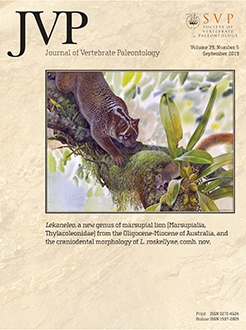We report a new early–middle Eocene cylindrodontid rodent, Gobiocylindrodon ulausuensis, gen. et sp. nov., from the Ula Usu West locality, Erlian Basin, Nei Mongol, China. Gobiocylindrodon ulausuensis is morphologically more primitive than known later cylindrodontids in having lower-crowned molars, less-rounded upper molars in occlusal view, a more oblique hypolophid on p4, a slightly anterolabially extended hypoconid on m1–3, and a narrow posterosinusid posteriorly and a broad mesosinusid anteriorly on the lower cheek teeth. The lower incisor enamel of G. ulausuensis is pauciserial. Our phylogenetic analysis of a data matrix including 14 taxa and 40 morphological characters reveals that G. ulausuensis is a basal cylindrodontid. Gobiocylindrodon ulausuensis casts new light on early cylindrodontid evolution in Asia and provides new evidence for mammalian dispersals between Asia and North America during the early–middle Eocene. Gobiocylindrodon-bearing strata are probably Arshantan in age.
BioOne.org will be down briefly for maintenance on 12 February 2025 between 18:00-21:00 Pacific Time US. We apologize for any inconvenience.
How to translate text using browser tools
14 April 2020
A New Eocene Cylindrodontid Rodent from the Erlian Basin (Nei Mongol, China) and Its Implications for Phylogeny and Biochronology
Qian Li,
Yuan Q. Wang,
Fang Y. Mao,
Jin Meng
ACCESS THE FULL ARTICLE






